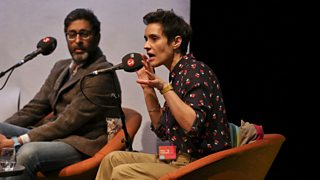How to make people laugh
All through March and April on Radio 3 we’ll be hearing from the Free Thinking Festival 2018 – where we recently learned that there’s a lot more to the art of stand-up comedy than just telling jokes.
During a blisteringly funny panel discussion that covered everything from heckling to the history of alternative comedy, stand-ups Alexei Sayle and Jen Brister gave their tips for getting large groups of people to laugh at your jokes.

Pick your venue carefully
“A lot of people think that comedy can work in any environment, but it absolutely can't,” says Brister. “The amount of times I've turned up in a room and the chairs aren't even facing the stage…”
The ideal room for comedy, according to Brister, is wide but not too long. The longer the room, the harder it is for the joke-teller to connect with people near the back. But the number of people in a venue is just as important as its shape, according to Alexei Sayle, a veteran of alternative comedy. “It has to be full,” he says. “I don't care if it's 50 or 5,000 seats, just as long as it's sold out. It's much more difficult if the room's empty.”
Treat your audience as a single entity, rather than a crowd of individuals
Once you’ve sorted your space, the next challenge faced by the newbie stand-up is the people in it. The audience. “My technique has always been to sense the audience as a single animal, rather than individuals,” says Sayle. “So when I do stand-up, I always make sure I have a light shining in my eyes. I always make sure I don't focus on individuals.”
Brister agrees. “Inevitably, if I do see anyone's individual face, they usually look absolutely livid – and that can really put me off,” she says. “So I try to think of the audience as an amorphous mass, rather than a group of individuals. That way I can tackle them a bit easier."
Sound out your audience...
Panel host and comedy fan Matthew Sweet was struck by the comic ingenuity of the late, great Ken Dodd. “He began throwing out lines of old songs to the audience: "You made me love you..." and someone would shout back the next line.

“I could see that he was testing the audience: how old they were, something about their background, so he knew that they would respond to humour about the coal man and the rent book – things that might not necessarily be in everyone's repertoire.”
… and get them on side ASAP
Imagine the scene. You’re out there on the stage, alone under the spotlight and rattling through your routine when suddenly a voice calls out from the audience, challenging something you’ve said. The room goes quiet. Or worse – there’s a ripple of laughter and an expectant silence.
For most professional joke-tellers, dealing with hecklers is a traumatic but inevitable part of the job. The solution, for Brister, lies in identifying where the power sits in the room. “If you have all the authority, it doesn't matter what someone shouts at you – you can get it back,” she says. “I find that if I've got the audience on my side and someone shouts at me, I can take my time. I spend a bit of time chatting to that person and help them dig their own grave.”
But without the audience on side, a stranded comic has just a split-second to respond to a heckle with something funny. If they don’t, they’re in trouble.

The changing face of UK comedy
Veteran of alternative comedy Alexei Sayle observes the evolution of UK comedy audiences.
Treat comedy like a conversation
After nearly 40 years in the comedy business, Sayle is an expert at reading the room. “Every split second, you're adjusting to the audience,” he says. “Your brain’s working at 1,000 miles per hour and you're responding to the energy in the room, second by second."
Brister, too, stresses the importance of tapping into that audience energy. “You're hyper-aware of everything that's going on in a room,” she says. “So if there's a dip, you know that that gag didn't hit the mark, or that you have to ramp up the energy.”
Sometimes though, it doesn’t matter how attuned you are to the audience’s mood – you just have to hope they’re up for having a good time. “There's an energy from the audience that really allows a comedian to hit their stride,” says Brister. “If the audience aren't with you, then it doesn't matter.
“Last night you might have had the best gig of your life. But the next day, if the audience aren't with you, you look awful. And there's no way of coming back from that, unfortunately."
Have some come-backs ready
Some comedians seem to positively flourish when put on the spot by hecklers, but Alexei Sayle isn’t one of them. "I used to have prepared put-downs,” he says. “On my last tour I was playing Bristol Colston Hall. I did a line and a bloke in the audience shouted out: ‘You said that the last time!’”
So I did one of my prepared put-downs, which was 'Well, you're a daft [&!%^!] to pay to hear it again then, aren't you?'" Cue waves of audience laughter, until the voice piped up again: “You said that last time as well!”
Be brave, and don’t be afraid to fail – often
Getting up on stage is only half the battle. Anyone who truly wants to achieve great stand-up must be prepared to “die” on stage, says Brister – and die painfully.

“The thing with stand-up comedy is that the more risks you take, the more chance there is of you failing,” she says. “I've seen Stewart Lee failing many, many times in order to get to the place where he wants to be. If you don't take those risks, you can sit comfortably with the laughs – but it doesn't mean you're a better comedian.
“If you want to do well and stand out, you have to allow yourself to die quite a few times to find out what will take you to the next level. That's what I consider to be brave."
Alexei Sayle, Jen Brister and Sanjeev Kohli join Matthew Sweet for a masterclass in making the many laugh. Free Thinking: Mass Hysterics is available from 27 March.
2018's Free Thinking Festival is devoted to The One and the Many: a chance to examine the fast-changing relationship between the individual and the crowd. Browse all of the season's fascinating programmes, clips and features on the Radio 3 website.
-
![]()
Mass Hysterics
Three comedians join Matthew Sweet for a masterclass in making the many laugh.
-
![]()
Should we stop having children?
With global population on the rise, could having kids be your biggest moral mistake?
-
![]()
Welling up: Women and water in the Middle Ages
Could medieval mystic Margery Kempe's excessive, noisy crying have made her more godly?
-
![]()
Free Thinking Festival 2018
Browse all programmes, clips and features from this year's fascinating exploration of The One and the Many.




